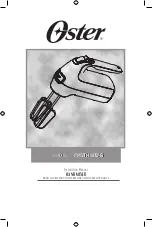
Tool Use and Care
15. Use clamps or other practical way to secure and support the work piece to a stable platform.
Holding the
work by hand or against your body is unstable and may lead to loss of control.
16. Do not force tool. Use the correct tool for your application.
The correct tool will do the job better and safer at
the rate for which it is designed.
17. Do not use tool if switch does not turn it on or off.
Any tool that cannot be controlled with the switch is
dangerous and must be repaired.
18. Disconnect the plug from the power source before making any adjustments, changing accessories, or
storing the tool.
Such preventive safety measures reduce the risk of starting the tool accidentally.
19. Store idle tools out of reach of children and other untrained persons.
Tools are dangerous in the hands of
untrained users.
20. Maintain tools with care. Keep cutting tools sharp and clean.
Properly maintained tools with sharp cutting
edges are less likely to bind and are easier to control.
21. Check for misalignment or binding of moving parts, breakage of parts, and any other condition that
may affect the tools operation. If damaged, have the tool serviced before using.
Many accidents are caused by
poorly maintained tools.
22. Use only accessories that are recommended by the manufacturer for your model.
Accessories that may be
suitable for one tool may become hazardous when used on another tool.
SERVICE
23.
Tool service must be performed only by qualified repair personnel. Service or maintenance performed by unqualified
personnel could result in a risk of injury.
24. When servicing a tool, use only identical replacement parts.
Follow instructions in the Maintenance section of
this manual. Use of unauthorized parts or failure to follow Maintenance instructions may create a risk of electric shock
or injury.
ADDITIONAL SAFETY INSTRUCTIONS FOR MIXERS:
The machine may be used only by people who are familiar with the operating instructions and the regula-
tons in force concerning work safety and accident prevention.
Take care to ensure that the current voltage indicated on the rating plate corresponds to that of the mains power sup-
ply.
Do not use the device in any environments with potentially explosive atmospheres. Do not mix any solvents
or solvent-containing substances with a flash point of below 21° C / 69° F.
Position the cord clear of the rotating mixing paddle. Do not wrap the cord around your arm, wrist or other
part of your body.
If you lose control and have the cord wrapped around your arm, wrist or other part of your body
it may entrap you and cause injury.
Use only cords approved for outdoor use
.
Start up and run down the machine in the mixing container only
. Ensure that the mixing container is stood in
a firm and secure position.
Do not reach into the mixing container with your hands or insert any other objects into it while mixing is in progress.
If the sound pressure level should exceed 85 dB (A) where you are working, use ear protection!
We recommend that you wear work gloves and protective goggles when using the mixer.
Regulations require that you wear close-fitting clothing.
Some dust created by mixing construction materials contains chemicals known to cause cancer, birth defects or other
reproductive harm. Some examples of the chemicals are:
• Lead from lead-based paints,
• Crystalline silica from bricks and cement and other masonry products, and
• Arsenic and chromium from chemically-treated lumber.
Your risk from these exposures varies, depending on howoften you do this type of work. To reduce your exposure to
these chemicals: work in a well ventilated area, and work with approved safety equipment, such as those dust masks
that are specially designed to filter out microscopic particles.
WARNING































